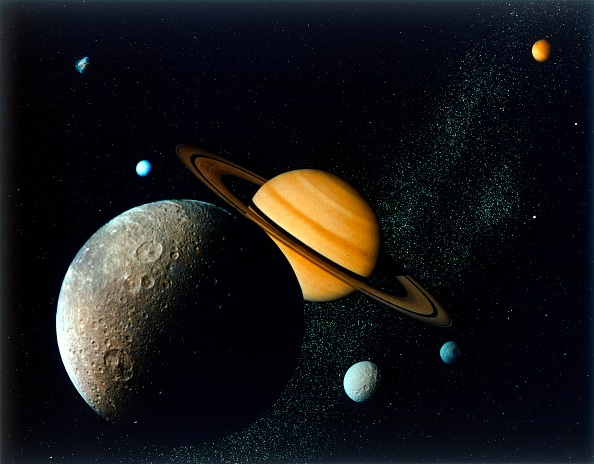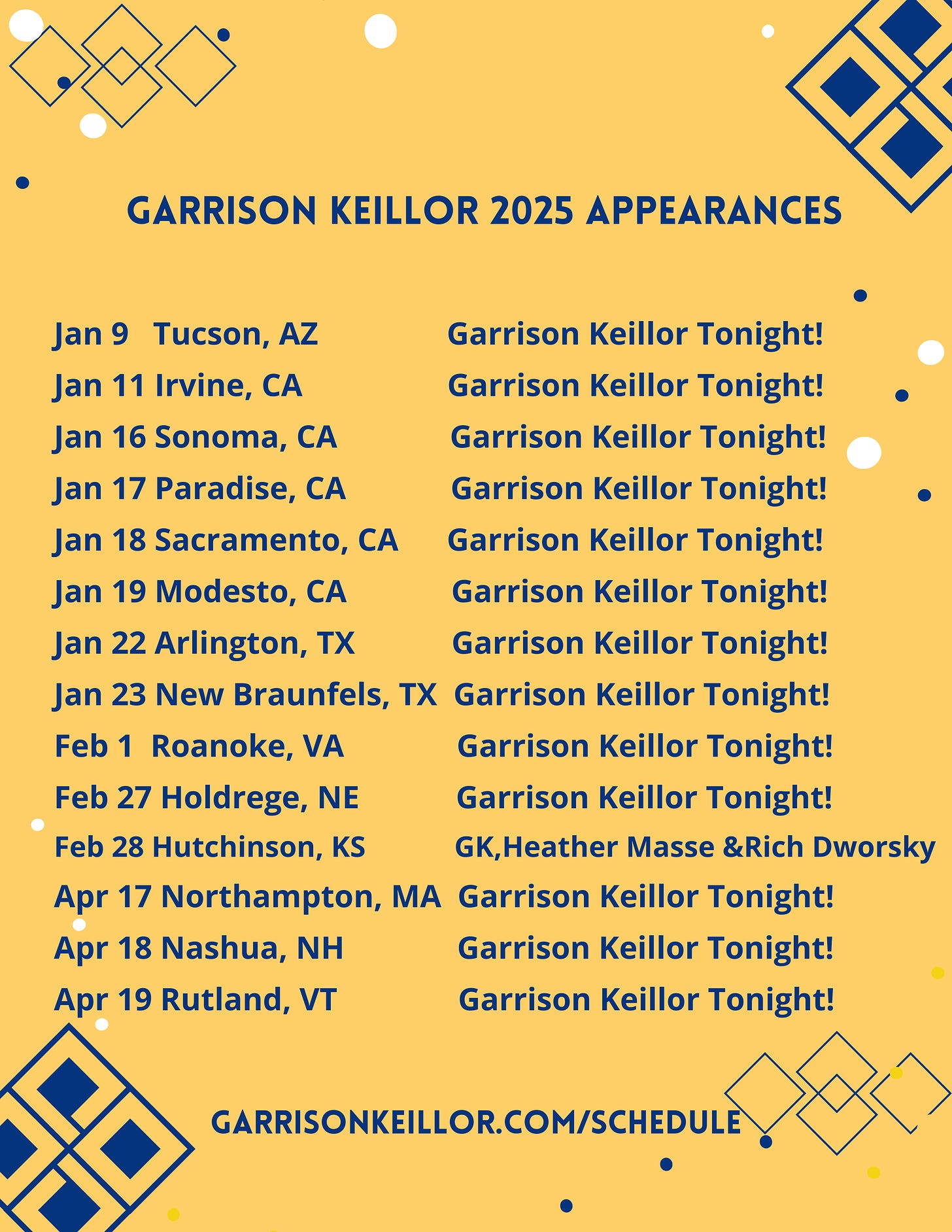The Writer's Almanac from Tuesday, November 12, 2013
"Gifted and Talented" by Krista Lukas, from Fans of My Unconscious. © The Black Rock Press, 2013.
ORIGINAL TEXT AND AUDIO - 2013
On this day in 1980, the NASA space probe Voyager 1 made its closest approach to Saturn. Of course, "close" is a relative term; in this case, the spacecraft was 40,000 miles from the top of the gas giant's cloud layer. But it gave scientists their best opportunity to study the planet's most famous feature: its spectacular rings. Voyager 1's images reveal seven main rings, each named with a letter of the alphabet and made up of thousands of strands held in formation by the gravitational pull of the planet and its dozens of moons. The rings are made of ice particles — some as big as a car — and bits of debris from broken up moons, comets, and asteroids. Voyager 1 also discovered the "shepherd moons": Prometheus and Pandora, small moons that interact with Saturn's "F" ring and keep it separate from the other rings.
Voyager 1 was launched in 1977, sent out into the solar system to explore Jupiter and Saturn along with its twin, Voyager 2. Both probes carry a greeting to any sentient life forms that they may encounter, in the form of a gold-plated record. The information on the record was selected and compiled by a committee chaired by Carl Sagan; it includes spoken greetings in 55 languages, a selection of music from different eras and cultures, and a variety of images and sound recordings from nature, including a baby crying, ocean waves, and whale song. President Jimmy Carter said: "This is a present from a small, distant world, a token of our sounds, our science, our images, our music, our thoughts and our feelings. We are attempting to survive our time so we may live into yours. We hope someday, having solved the problems we face, to join a community of galactic civilizations. This record represents our hope and our determination, and our good will in a vast and awesome universe."
The original plan was for Voyager 1 to explore Saturn's moon Titan, and then continue on to other moons and planets. But the gravity of Titan spun the probe off into an unexpected direction and put it on a path for deep space. Scientists debated whether to correct Voyager's trajectory and send it past Pluto, or let it continue on. The latter course promised more interesting data, and less risk, so they opted not to interfere.
According to NASA, 11,000 workyears have been devoted to the Voyager project from its inception in 1972 until its encounter with Neptune in 1988; that sounds like a lot, but it's only about one-third the effort that went into building the Great Pyramid of Giza. The cost for the mission works out to about eight cents per U.S. resident per year. The probes are fuel-efficient too, getting about 30,000 miles to the gallon of rocket fuel; they use the gravity of the planets they're studying to "slingshot" them along to their next destination.
On Valentine's Day, 1990, Voyager 1 was in a position to take what's come to be known as a "family portrait" of our solar system. The series of photographs captures six of the planets; Mercury and Mars were caught in the glare of the Sun, and Pluto was too small and dim to show up. These were the last pictures that Voyager 1 took; the cameras were shut down afterward to conserve power.
In August 2012, Voyager 1 left the solar system and entered interstellar space. It's now the most distant human-made object in space — almost 19 billion kilometers as of October 2013 — and it continues to send back data, via the Deep Space Network, to highly sensitive equipment here on Earth. Voyager is so far away that the signal it sends back takes 17 hours to reach us, and is 20 billion times weaker than a digital watch. It's expected to be able to continue its mission until about 2025, when its generators will no longer be able to provide sufficient power.
It's the birthday of feminist Elizabeth Cady Stanton, born in Johnstown, New York (1815). When her brother died, she was allowed to take his place in the Johnstown Academy; previously she hadn't been admitted. She won honors there, but even so, no college would take her. She studied law in her father's office, but wasn't allowed to take the bar exam or practice. In 1848, the first women's rights convention in America was held near her home in Seneca Falls, New York. With Susan B. Anthony and Matilda Joslyn Gage, she compiled the first three volumes of The History of Woman Suffrage.
Stanton said: "The moment we begin to fear the opinions of others and hesitate to tell the truth that is in us, and from motives of policy are silent when we should speak, the divine floods of light and life no longer flow into our souls."
It's the birthday of the founder of Reader's Digest, DeWitt Wallace, born in St. Paul, Minnesota (1889). His father was a professor of Greek and Old English at Macalester College, but Wallace rebelled against his father's example and fell in love with business. As a young man, he was always trying to make a buck, raising chickens, selling vegetables from his garden, and operating an electrical repair service.
After college, he worked for a publishing house that specialized in agricultural textbooks. While working there, he learned that the federal government had all kinds of free informational pamphlets that were available to farmers, but most farmers didn't even know these pamphlets existed. So he decided to publish and sell a condensed collection of the free pamphlets to farmers, called Getting the Most Out of Farming. It was a huge success, and Wallace decided that making information easily available was the secret to the publishing industry.
He was still trying to figure out what to do next when World War I broke out, and he enlisted in the Army. He was seriously wounded in 1918. During his recovery, he read hundreds of magazines, and he suddenly realized that a pocket-sized magazine full of condensed general-interest articles from other magazines could be a big hit. He compiled a sample issue of the first Reader's Digest. The first issue came out in February 1922. People didn't think it would last because it was just a reprint journal, but Wallace had a talent for finding those stories that appealed to the widest number of people. By the end of the decade, Reader's Digest went on to become the most successful magazine of all time, with 39 editions in 15 languages, and a total circulation of almost 30 million magazines a month.
It's the birthday of journalist and short-story writer Tracy Kidder, born in New York City (1945), who started out as a fiction writer, but decided early on that he preferred writing about real people. In the late 1970s, he spent eight months living in the basement of Data General Corporation, watching the engineers at work on a new microcomputer. He described the engineers as, "knights errant, clad in blue jeans and open collars, seeking with awesome intensity the grail of technological achievement. ... They believe that what they do is elegant and important, but they have the feeling that no one else understands or cares." Kidder's book The Soul of a New Machine was one of the first nontechnical books about the computer industry, and it won the Pulitzer Prize when it came out in 1981.
Kidder went on to write a series of books about apparently ordinary topics. For his book House (1985), he wrote about the construction of a single house in Amherst, Massachusetts, because he said, "[Building] is the quintessential act of civilization." To write his book Among Schoolchildren (1989), he sat in a single fifth-grade classroom in an impoverished public school for an entire school year.
Be well, do good work, and keep in touch.®
Click on the image below for ticket details!






Imagine! All that increase in knowledge for 8 cents a year. WOW